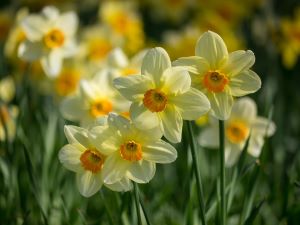
There’s nothing quite like a field of colorful tulips against a blue sky, or clusters of crocus flowers and daffodils to signify spring. Winter can seem interminable at times, but those colorful flowers are a reminder that the cold will recede eventually. And with a little work in the fall, you can ensure a yard full of those glorious harbingers of spring.
Bulbs should be planted when the ground begins to cool, usually around the first frost, but do get them in the ground before it freezes. It can be overwhelming when you see the many different varieties that are available, but imagine your garden as an artist would see it. Clusters of bulbs will make the most impact, but lining a walkway can be equally enchanting. As for color, let your taste rule. Do you like flowers in similar shades or do you prefer a jumble of color? Either one will be beautiful. You might want to keep in mind the height of the flowers, planting the shorter ones in front, and keep in mind the flowering times of the bulbs you have chosen as well. But other than that, you can let your design go wild.
One rule of thumb, and perhaps the most important one, is that the ground must drain well. Bulbs do not like soggy soil. Bulbs also like sun and lots of it, though this isn’t usually a problem since many bulbs flower before trees have leafed out.
If you’ve never planted anything in the spot you have chosen, make sure to till the soil and get rid of any rocks, large roots, or sticks. It will also help to add in some compost or peat moss to help condition the soil.

Bulbs should be planted with the pointed end up but sometimes it’s hard to tell. In that case, you can plant the bulb on its side. But even if you get it wrong, the flower will find the sun. If you’re planting large clusters of flowers, you may want to dig a trench, or you can plant them one by one. Larger bulbs should be planted about 8” deep while the smaller ones will be buried about 3” deep. A general rule is to plant the bulb about three times as deep as the diameter of the bulb. I have found that the right tool can help make the planting easier. Our Kuro Hori-Hori knife is great for digging in even the toughest soil and includes depth marks so you can easily see how deep a hole you’re digging.
You should water your bulbs thoroughly after planting. If you want to use fertilizer, choose one made specifically for bulbs. You may want to consider using animal repellent too, since bulbs can be a favorite for voles, chipmunks, deer, and rabbits.
Once your flowers have bloomed and died, don't cut the leaves back until they've yellowed and wilted. The plants need them to create food and strengthen the bulbs for the next growing season.
When snow is blanketing the ground and those first tender shoots start to come up, you will begin to envision warmer weather and all your work now will be so worth it!


